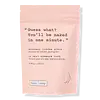What's inside
What's inside
 Key Ingredients
Key Ingredients

 Benefits
Benefits

 Concerns
Concerns

 Ingredients Side-by-side
Ingredients Side-by-side

Sodium Chloride
MaskingCarthamus Tinctorius Seed Oil
MaskingSilica
AbrasiveButyrospermum Parkii Butter
Skin ConditioningGigartina Skottsbergii Extract
Skin ConditioningOlea Europaea Fruit Oil
MaskingOryza Sativa Bran Extract
Skin ConditioningRosmarinus Officinalis Extract
AntimicrobialHelianthus Annuus Seed Extract
Skin ConditioningTocopherol
AntioxidantIllite
AbrasiveLavandula Angustifolia Oil
MaskingSodium Olivate
CleansingPersea Gratissima Oil
Skin ConditioningOrbignya Oleifera Seed Oil
EmollientSodium Chloride, Carthamus Tinctorius Seed Oil, Silica, Butyrospermum Parkii Butter, Gigartina Skottsbergii Extract, Olea Europaea Fruit Oil, Oryza Sativa Bran Extract, Rosmarinus Officinalis Extract, Helianthus Annuus Seed Extract, Tocopherol, Illite, Lavandula Angustifolia Oil, Sodium Olivate, Persea Gratissima Oil, Orbignya Oleifera Seed Oil
 Reviews
Reviews

Ingredients Explained
These ingredients are found in both products.
Ingredients higher up in an ingredient list are typically present in a larger amount.
Chances are, you eat sodium chloride every day. Sodium Chloride is also known as table salt.
This ingredient has many purposes in skincare: thickener, emulsifier, and exfoliator.
You'll most likely find this ingredient in cleansers where it is used to create a gel-like texture. As an emulsifier, it also prevents ingredients from separating.
There is much debate on whether this ingredient is comedogenic. The short answer - comedogenic ratings don't tell the whole story. Learn more about comegodenic ratings here.
The concensus about this ingredient causing acne seems to be divided. Research is needed to understand if this ingredient does cause acne.
Scrubs may use salt as the primary exfoliating ingredient.
Learn more about Sodium ChlorideTocopherol (also known as Vitamin E) is a common antioxidant used to help protect the skin from free-radicals and strengthen the skin barrier. It's also fat soluble - this means our skin is great at absorbing it.
Vitamin E also helps keep your natural skin lipids healthy. Your lipid skin barrier naturally consists of lipids, ceramides, and fatty acids. Vitamin E offers extra protection for your skin’s lipid barrier, keeping your skin healthy and nourished.
Another benefit is a bit of UV protection. Vitamin E helps reduce the damage caused by UVB rays. (It should not replace your sunscreen). Combining it with Vitamin C can decrease sunburned cells and hyperpigmentation after UV exposure.
You might have noticed Vitamin E + C often paired together. This is because it is great at stabilizing Vitamin C. Using the two together helps increase the effectiveness of both ingredients.
There are often claims that Vitamin E can reduce/prevent scarring, but these claims haven't been confirmed by scientific research.
Learn more about Tocopherol